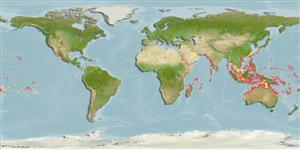Environment: milieu / climate zone / depth range / distribution range
Écologie
marin récifal; non migrateur; profondeur 0 - 80 m (Ref. 128797). Tropical; 35°N - 35°S
Indo-Pacific: Red Sea (Ref. 7247) and East Africa to Samoa and Tonga (Ref. 53797), north to the Ryukyu Islands, south to New Caledonia.
Taille / Poids / Âge
Maturity: Lm ? range ? - ? cm
Max length : 10.5 cm TL mâle / non sexé; (Ref. 90102)
Description synthétique
Clés d'identification | Morphologie | Morphométrie
Épines dorsales (Total) : 12 - 13; Rayons mous dorsaux (Total) : 10 - 12; Épines anales: 2; Rayons mous anaux: 10 - 12.
Schools are found above branching corals along upper margins of clear lagoon and outer reef slopes. Often associated with branching Acropora. Oviparous, distinct pairing during breeding (Ref. 205). Eggs are demersal and adhere to the substrate (Ref. 205). Males guard and aerate the eggs (Ref. 205). Diurnal species (Ref. 54980, 120737).
Life cycle and mating behavior
Maturities | Reproduction | Spawnings | Egg(s) | Fecundities | Larves
Oviparous, distinct pairing during breeding (Ref. 205). Eggs are demersal and adhere to the substrate (Ref. 205). Males guard and aerate the eggs (Ref. 205).
Allen, G.R., 1991. Damselfishes of the world. Mergus Publishers, Melle, Germany. 271 p. (Ref. 7247)
Statut dans la liste rouge de l'IUCN (Ref. 130435)
Menace pour l'homme
Harmless
Utilisations par l'homme
Pêcheries: sans intérêt; Aquarium: Commercial
Outils
Articles particuliers
Télécharger en XML
Sources Internet
Estimates based on models
Preferred temperature (Ref.
123201): 24.6 - 28.9, mean 27.7 °C (based on 666 cells).
Phylogenetic diversity index (Ref.
82804): PD
50 = 0.5000 [Uniqueness, from 0.5 = low to 2.0 = high].
Bayesian length-weight: a=0.02344 (0.01352 - 0.04066), b=3.04 (2.89 - 3.19), in cm total length, based on LWR estimates for this species & Genus-body shape (Ref.
93245).
Niveau trophique (Ref.
69278): 3.4 ±0.45 se; based on food items.
Résilience (Ref.
120179): Haut, temps minimum de doublement de population inférieur à 15 mois (K=4.0).
Fishing Vulnerability (Ref.
59153): Low vulnerability (10 of 100).
Nutrients (Ref.
124155): Calcium = 112 [55, 177] mg/100g; Iron = 0.839 [0.490, 1.399] mg/100g; Protein = 18.3 [17.1, 19.4] %; Omega3 = 0.126 [0.071, 0.213] g/100g; Selenium = 23.5 [11.8, 47.1] μg/100g; VitaminA = 152 [45, 491] μg/100g; Zinc = 1.45 [0.95, 2.09] mg/100g (wet weight);
